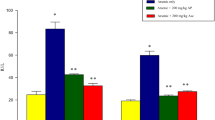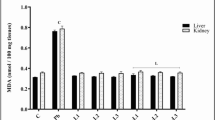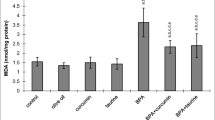Abstract
Bisphenol A (BPA) exposure has been shown to induce oxidative stress. Despite advances in medicine, treatment implementation remains a challenge; however, medicinal plants have shown usefulness in the management of oxidative stress-induced pathogenesis. The study explored the effect of ethanolic extracts of Petiveria alliacea (P. alliacea), commonly called green hen weed in BPA-induced alterations in the hepato-renal system of a rat model. BPA-intoxicated rats were given water, 50, 100, and 200 mg/kg ethanolic extracts of P. alliacea (EPA) separately for 21 days. BPA administration increased plasma alanine transferase, aspartate transferase, creatinine, and total bilirubin. Furthermore, it decreased the activity of catalase, glutathione-S-transferase, glutathione, and malondialdehyde concentrations in the kidney and liver. Administration of EPA at all doses restored all the values to near normalcy relative to the control in both the kidney and liver. Histology also confirmed these findings. Ethanolic leaf extracts of P. alliacea provide protection against BPA-induced toxicity in the hepato-renal system through the antioxidant pathways.




Similar content being viewed by others
Availability of data
All data used in the study are included in the manuscript.
References
Adeyi AA, Babalola BA (2019) Bisphenol-A (BPA) in foods commonly consumed in Southwest Nigeria and its human health risk. Sci Rep 9(1):1–13. https://doi.org/10.1038/s41598-019-53790-2
Aebi H (1984) Catalase in vitro. Methods Enzymol 105:121–126
Anand U, Jacobo-Herrera N, Altemimi A, Lakhssassi N (2019) A comprehensive review on medicinal plants as antimicrobial therapeutics: potential avenues of biocompatible drug discovery. Metabolites 9(11):258. https://doi.org/10.3390/metabo9110258
Bartels H, Böhmer M, Heierli C (1972) Serum Kreatinibestimmung ohne Enteiweissen [Serum creatinine determination without protein precipitation]. Clin Chim Acta 37:193–7. German. https://doi.org/10.1016/0009-8981(72)90432-9. PMID: 5022083
Basini G, Bussolati S, Grolli S, Ramoni R, Grasselli F (2017) Bisphenol A interferes with swine vascular endothelial cell functions. Can J Physiol Pharmacol 95(4):365–371. https://doi.org/10.1139/cjpp-2016-0180
Beutler E, Duron O, Kelly BM (1963) Improved method for the determination of blood glutathione. J Lab Clin Med 61:882–888
de Andrade TM, de Melo AS, Dias RGC, Verela ELP, de Oliveira FR, Vieira JLF et al (2012) Potential behavioral and pro-oxidant effects of Petiveria alliacea L. extract in adult rats. J Ethnopharmacol 28:143(2):604–10. https://doi.org/10.1016/j.jep.2012.07.020
Eid JI, Eissa SM, Ghor AA (2015) Bisphenol A induces oxidative stress and DNA damage in hepatic tissue of female rat offspring. J Basic Appl Zool 71:10–19. https://doi.org/10.1016/j.jobaz.2015.01.006
Evans WC (2009) Trease and evans' pharmacognosy E-book. 16th ed. Saunders Elsevier Health Sciences
Eweda SM, Newairy AA, Abdou HM, Garber AS (2020) Bisphenol A-induced oxidative damage in the hepatic and cardiac tissues in rats: the modulatory role of sesame lignans. Exp Ther Med 19:33–34. https://doi.org/10.3892/etm.2019.8193
Gassman NR (2017) Induction of oxidative stress by bisphenol A and its pleiotropic effects. Environ Mol Mutagen 58(2):60–71. https://doi.org/10.1002/em.22072
García-Pérez M, Alfonson-Castilo A, Lores OF, Batista-Duharte A, Lemuse-Rodriguez Z (2018) Toxicological evaluation of an aqueous suspension from leaves and stems of Petiveria alliacea L. (Phytolaccaceae). J Ethnopharmacol 211:29–37. http://hdl.handle.net/11449/170200
Goncalves GD, Semprebon SC, Biazi BI, Mantovani MS, Fernandes GSA (2018) Bisphenol A reduces testosterone production in TM3 Leydig cells independently of its effects on cell death and mitochondrial membrane potential. Reprod Biol 76:26–34. https://doi.org/10.1016/j.reprotox.2017.12.002
Habig WH, Pabst MJ, Jakoby WB (1974) Glutathione S-transferases. The first enzymatic step in mercapturic acid formation. J Biol Chem 25:7130–7139
Hassan ZK, Elobeid MA, Virk P, Omer SA, ElAmin M, Daghestani MH et al (2012) Bisphenol A induces hepatotoxicity through oxidative stress in rat model. Oxid Med Cell Longev. https://doi.org/10.1155/2012/194829
Hines M, Constantinescu M, Spencer D (2015) Early androgen exposure and human gender development. Biol Sex Differ 6:3. https://doi.org/10.1186/s13293-015-0022-1
Huang X, Cang X, Liu J (2019) Molecular mechanism of bisphenol A on androgen receptor antagonism. Toxicol In Vitro 61:104621. https://doi.org/10.1016/j.tiv.2019.104621
Husseine RM, Eid JI (2013) Pathological mechanisms of liver injury caused by oral administration of bisphenol A. Life Sci J 10(1)
Iroaganachi M, Eleazu CO, Ojafor PN, Nwaohu N (2015) Effect of unripe plantain (Musa paradisiaca) and ginger (Zingiber officinale) on blood glucose, body weight and feed intake of Streptozotocin-induced diabetic rats. Open Biochem J 9:1–6
Jendrassik L, Grof P (1938) Simplified photometric methods for the determination of bilirubin. Biochem J 297:81–89
Kobroob A, Peerapanyasut W, Chattipakorn N, Wongmekiat O (2018) Damaging effects of bisphenol A on the kidney and the protection by melatonin: emerging evidences from in vivo and in vitro studies. Oxid Med Cell Longev Vol 2018/ID 3082438. https://doi.org/10.1155/2018/3082438
Kourouma A, Quan C, Duan P, Qi S, Yu T, Wang Y et al (2015) Bisphenol A induces apoptosis in liver cells through induction of ROS. Adv Toxicol 3:10. https://doi.org/10.1155/2015/901983
Lopes-Martins RAB, Pegoraro DH, Woisky R, Penna SC, Sertié JAA (2002) The anti-inflammatory and analgesic effects of a crude extract of Petiveria alliacea L. (Phytolaccaceae). Phytomedicine 9(3):245–248. https://doi.org/10.1078/0944-7113-00118
Mahdavinia M, Khorsandi L, Alboghobeish S, Samimi A, Dehghani MA, Zeidooni L (2021) Liver histopathological alteration and dysfunction after bisphenol A administration in male rats and protective effects of naringin. Avicenna J Phytomedicine 11(4):394–406. https://doi.org/10.22038/AJP.2021.17649
Mahmoudi A, Hadrich F, Feki I et al (2018) Oleuropein and hydroxytyrosol-rich extracts from olive leaves attenuate liver injury and lipid metabolism disturbance in bisphenol A-treated rats. Food Funct 9(6):3220–3234
Morin A, Van de Beeck L, Person E, Plasmondon H (2021) Adult male rats show resilence to adolescent bisphenol A effects on hormonal and behavioral responses while co-exposure with hop extracts support synergistic actions. Front Toxicol Article 639820. https://doi.org/10.3389/ftox.2021.639820
Ohore OE, Zhang S (2019) Endocrine disrupting effects of bisphenol A exposure and recent advances on its removal by water treatment systems. A review. Sci Afr 5:e00135. https://doi.org/10.1016/j.sciaf.2019.e00135
Ola-Davies OE, Olukole SG (2018) Gallic acid protects against bisphenol A –induced alterations in the cardio-renal system of Wistar rats through the antioxidant defense mechanism. Biomed Pharmacother 107:1786–1789
Ozaydın T, Oznurlu Y, Sur E, Celik I, Uluısık D, Dayan MO (2018) Effects of bisphenol A on antioxidant system and lipid profile in rats. Biotech Histochem 93(4):231–238
Poormoosavi SM, Najafzadehvarzi H, Behmanesh MA, Amirgholami R (2018) Protective effects of Asparagus officinalis extract against bisphenol A-induced toxicity in Wistar rats. Toxicol Rep 5: 427–433. https://doi.org/10.1016/j.toxrep.2018.02.010
Reitman S, Frankel S (1957) A colorimetric method for the determination of serum glutamic oxalacetic and glutamic pyruvic transaminases. Am J Clin Pathol 8(1):56–63. https://doi.org/10.1093/ajcp/28.1.56
Robinson MM, Zhang X (2011) The world medicines situation 2011, traditional medicines: global situation, issues and challenges. World Health Organization; Geneva, Switzerland 1–4
Schug TT, Birnbaum LS (2014) Human health effects of bisphenol A. Toxicants in Food Packaging and Household Plastics. p. 1–29. https://doi.org/10.1007/978-1-4471-6500-2_1
Shirani M, Alizadeh S, Mahdavinia M, Dehghani MA (2018) The ameliorative effect of quercetin on bisphenol A induced toxicity in mitochondria isolated from rats. Environ Sci Pollut Res. https://doi.org/10.1007/s11356-018-04119-5
Sofowora A (1993) Recent trends in research into African medicinal plants. J Ethnopharmacol 38(2–3):197–208
Urueña C, Cifuentes C, Castaneda D, Arango A, Kaur P, Asea A et al (2008) Petiveria alliacea extracts uses multiple mechanisms to inhibit growth of human and mouse tumoral cells. BMC Complement Alternative Med 8. https://doi.org/10.1186/1472-6882-8-60
Varshney R, Kale RK (1990) Effects of calmodulin antagonists on radiation-induced lipid peroxidation in microsomes. Int J Radiat Bio l58 (5): 733–43
Acknowledgements
The authors appreciate the technologist of the Department of Chemical Sciences, Anchor University Lagos, Nigeria.
Author information
Authors and Affiliations
Corresponding author
Ethics declarations
Funding
This research did not receive any grant from funding agencies in the public, commercial, or not-for-profit sectors.
Conflict of interest
The authors declare no competing interests.
Ethical approval
All procedures were performed in accordance with the ethical standards as recommended by the International Committee of Medical Journal Editors.
Informed consent
Informed consent is not required in this study.
Consent for publication
Consent for publication is not required in this study.
Additional information
Publisher's Note
Springer Nature remains neutral with regard to jurisdictional claims in published maps and institutional affiliations.
Rights and permissions
Springer Nature or its licensor (e.g. a society or other partner) holds exclusive rights to this article under a publishing agreement with the author(s) or other rightsholder(s); author self-archiving of the accepted manuscript version of this article is solely governed by the terms of such publishing agreement and applicable law.
About this article
Cite this article
Ojo, O.O., Imhansuomon, P.T. & Nwaechefu, O.O. Green hen weed (Petiveria alliacea) protects against bisphenol A-induced toxicity in the hepato-renal system. Comp Clin Pathol 32, 607–615 (2023). https://doi.org/10.1007/s00580-023-03469-y
Received:
Accepted:
Published:
Issue Date:
DOI: https://doi.org/10.1007/s00580-023-03469-y




